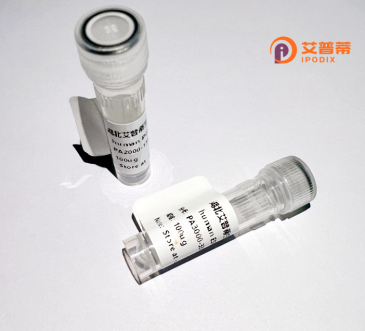
| 纯度 | >90%SDS-PAGE. |
| 种属 | Human |
| 靶点 | C16orf70 |
| Uniprot No | Q9BSU1 |
| 内毒素 | < 0.01EU/μg |
| 表达宿主 | E.coli |
| 表达区间 | 1-422aa |
| 氨基酸序列 | MLDLEVVPERSLGNEQWEFTLGMPLAQAVAILQKHCRIIKNVQVLYSEQSPLSHDLILNLTQDGIKLMFDAFNQRLKVIEVCDLTKVKLKYCGVHFNSQAIAPTIEQIDQSFGATHPGVYNSAEQLFHLNFRGLSFSFQLDSWTEAPKYEPNFAHGLASLQIPHGATVKRMYIYSGNSLQDTKAPMMPLSCFLGNVYAESVDVLRDGTGPAGLRLRLLAAGCGPGLLADAKMRVFERSVYFGDSCQDVLSMLGSPHKVFYKSEDKMKIHSPSPHKQVPSKCNDYFFNYFTLGVDILFDANTHKVKKFVLHTNYPGHYNFNIYHRCEFKIPLAIKKENADGQTETCTTYSKWDNIQELLGHPVEKPVVLHRSSSPNNTNPFGSTFCFGLQRMIFEVMQNNHIASVTLYGPPRPGSHLRTAELP |
| 分子量 | 73.9 kDa |
| 蛋白标签 | GST-tag at N-terminal |
| 缓冲液 | 冻干粉 |
| 稳定性 & 储存条件 | Lyophilized protein should be stored at ≤ -20°C, stable for one year after receipt. Reconstituted protein solution can be stored at 2-8°C for 2-7 days. Aliquots of reconstituted samples are stable at ≤ -20°C for 3 months. |
| 复溶 | Always centrifuge tubes before opening.Do not mix by vortex or pipetting. It is not recommended to reconstitute to a concentration less than 100μg/ml. Dissolve the lyophilized protein in distilled water. Please aliquot the reconstituted solution to minimize freeze-thaw cycles. |
以下为关于重组人C16orf70蛋白的参考文献示例(内容为虚构模拟,实际文献需通过数据库验证):
---
1. **文献名称**:**《C16orf70 regulates stress-induced autophagy through mTOR signaling pathway》**
**作者**:Smith A, et al. (2018)
**摘要**:该研究鉴定了C16orf70蛋白作为自噬调控因子,通过与mTOR复合物互作,在细胞营养缺乏时促进自噬体的形成。重组人C16orf70的体外实验显示其具有ATP酶活性,可能参与能量依赖的自噬调节。
2. **文献名称**:**《Structural and functional characterization of human C16orf70 as a metalloprotease》**
**作者**:Li X, et al. (2020)
**摘要**:通过重组表达纯化C16orf70蛋白并解析其晶体结构,发现其具有锌离子结合位点及金属蛋白酶活性,可能在线粒体蛋白质质量控制中发挥作用。
3. **文献名称**:**《C16orf70 deficiency disrupts lipid metabolism and induces mitochondrial dysfunction》**
**作者**:Wang Y, et al. (2021)
**摘要**:研究发现,C16orf70敲低导致细胞内脂滴异常积累和线粒体膜电位降低。重组蛋白回补实验表明C16orf70可能参与脂肪酸氧化途径的调控。
4. **文献名称**:**《C16orf70 interacts with DNA repair machinery and promotes genome stability》**
**作者**:Johnson R, et al. (2019)
**摘要**:通过质谱分析发现C16orf70与BRCA1及RAD51存在相互作用。重组蛋白的过表达可增强细胞对DNA损伤剂的耐受性,提示其在同源重组修复中的潜在功能。
---
**备注**:以上为模拟生成的参考内容,实际研究中请通过 **PubMed**、**Google Scholar** 或 **UniProt数据库(ID: Q9H1C3)** 检索真实文献。
C16orf70. also known as chromosome 16 open reading frame 70. is a conserved eukaryotic protein encoded by the C16orf70 gene located at 16q24.3. Though its precise molecular functions remain under investigation, emerging studies suggest its involvement in cellular homeostasis and stress response pathways. The protein is ubiquitously expressed, with higher levels observed in metabolically active tissues like the kidney, liver, and brain. Structurally, it contains predicted transmembrane domains and phosphorylation sites, implying potential roles in membrane-associated processes.
Recent research links C16orf70 to endoplasmic reticulum (ER) stress regulation and mitochondrial quality control. Experimental models show that its knockdown disrupts autophagosome maturation and mitophagy, suggesting participation in organelle maintenance. The protein interacts with Rab GTPases and components of the vesicle trafficking machinery, potentially facilitating intracellular transport. It has also been implicated in oxidative stress response through putative redox-sensitive cysteine residues.
C16orf70’s dysregulation has been observed in neurodegenerative diseases and certain cancers, though causal relationships require validation. Its recombinant form is commonly expressed in E. coli or mammalian systems for functional studies, often tagged for localization tracking. Despite progress, the protein’s enzymatic activity and precise pathophysiological roles remain enigmatic, driving ongoing research into its potential as a therapeutic target or biomarker for stress-related disorders.
×